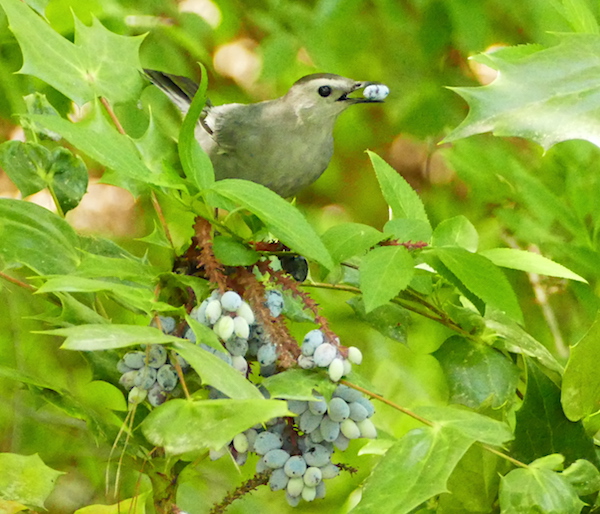MLS Mailbag No. 7
May 27, 2023
As a birder, my favorite exhibit at the museum is Explore the Wild: Wetland. How many bird species are typically seen here per year? — Jonah
If you’re a frequent flyer (I AM NOT SORRY) on the Museum blog, you are surely acquainted with Ranger Greg, our resident park naturalist who is widely known for his knowledge of all things nature here at the Museum, including the local bird community. Asking him this question was a no-brainer.
“I’ve personally seen about 140 species of birds on or above the museum property,” Greg said. “Not all those species are exclusive to the wetlands. I spend most of my time very close to the wetlands, and most species have been seen either from the path around the wetlands or within, say, 50 to 100 feet or so from the wetlands proper.”
So, roughly 140 species around the Museum’s outdoor spaces, with a good portion of those being spotted down Wetlands way!
I’m a birding super-novice, so I took the opportunity to prod Ranger Greg for birds to look out for.
“I don’t have a favorite, they’re all cool, interesting, or unique in their own way, but I’m very fond of gray catbirds,” he said.

If you’re planning to scan the area for our winged friends, you are likely to notice common native birds like the northern cardinal or Carolina chickadee most often.

“One species (among others) I’ve seen on only one occasion and don’t expect to see again is northern harrier,” Ranger Greg said. “They’re raptors of open country, marshes, fields and the like. I saw one about 13 years ago while it was migrating south in December at great height over Catch the Wind.”
I’m interested in Venus flytraps and other carnivorous plants. I know they grow in coastal areas of NC. What are the different kinds and how do they get nutrients? — Deb
Exposing myself as a theatre kid but growing up, I was thrilled to learn that something like Little Shop of Horrors’ Audrey II actually existed in our world. Granted, not conversational, but carnivorous nonetheless!
Carnivorous plants are a unique group of plants that get most of their nutrients from eating insects and other arthropods.
“They use enzymes and bacteria to break down their prey, similar to digestion in animals,” Manager of Horticulture Bobbi Jo Holmes said. “Some different types of ‘bug-eating’ plants include pitcher plants, sundews, butterworts, bladderworts, and flytraps. They all have different trapping mechanisms, which aid in their ability to capture their prey. Some use a pit-fall method, while others use flytrap mechanism. Most of them don’t need to actively move to catch their prey, like pitcher plants and butterworts, but flytraps and sundews sense an insect and moves quickly to capture it!”
Mind blown? Imagine a human baby being fed via “airplane method” and that’s a pitcher plant. Sort of. The below is definitely a pitcher plant (and one you can visit at the Museum).

Most species of carnivorous plants grow in boggy sites in all parts of the world, except Antarctica as they require bright light and prefer rainwater (tap water can actually harm them). According to the Nature Conservancy, an astounding 36 of the United States’ 66 native species can be found in North Carolina. So the next time you’re at the Museum, check out the tropical pitcher plants hanging in the Magic Wings Butterfly House and the native carnivorous plant collection next to the wooden raised beds just down from Sprout Café.
What are the animals’ names in Carolina Wildlife? — kaitlyn__sarah_ on Instagram
It is my distinct pleasure and delight to inform you all that every animal on the Animal Care Team has a name — except the fish, although my dear colleague Senior Director of Animal Care Sherry Samuels tells me that is up for debate.
Names come about in a few different ways. Some animals have come to the museum with names already. That would include our ring-tailed lemurs, most of the Farmyard (except Lightning), and the raptors in Carolina Wildlife. The aviary birds in Carolina Wildlife, however, all got their names from the Animal Care Team that takes care of them on a daily basis. The third way (arguably my favorite) is through public vote, the most recent of which is our trio of alligators, Snap, Crackle, and Pop.

Here are the names of the other Carolina Wildlife residents!
- Right Dot the salamander
- Cricket the kestrel
- Milton the mink
- Aya the merlin
- Lord Tubbington the box turtle
- Spot the spotted turtle
- Rhr and Oscar the water turtles
- Speedy and Poppy the American robins
- Luca, Youngdove, Blueband/Colman the mourning doves
- Waldo the bluebird
- Polo the water snake
- Yellow the yellow rat snake
- Sam the black rat snake
- Darwin the northern pine snake

Be sure to say hi, but please don’t tap on the glass.
——
That’s all for now, y’all! I hope you will join me next time for more questions and more answers.
If you have a question you’d like answered or are counting down the days till Greta Gerwig’s Barbie comes out, you can drop us a note here.
